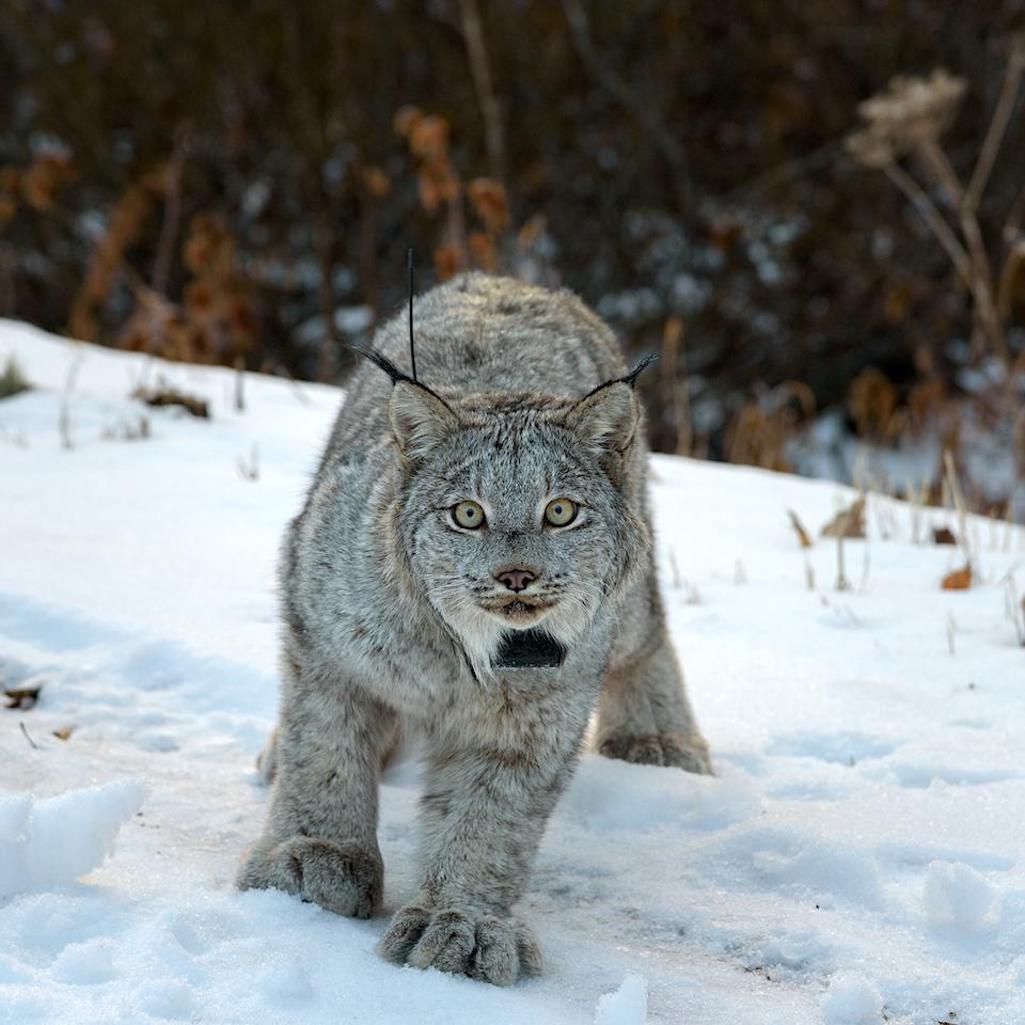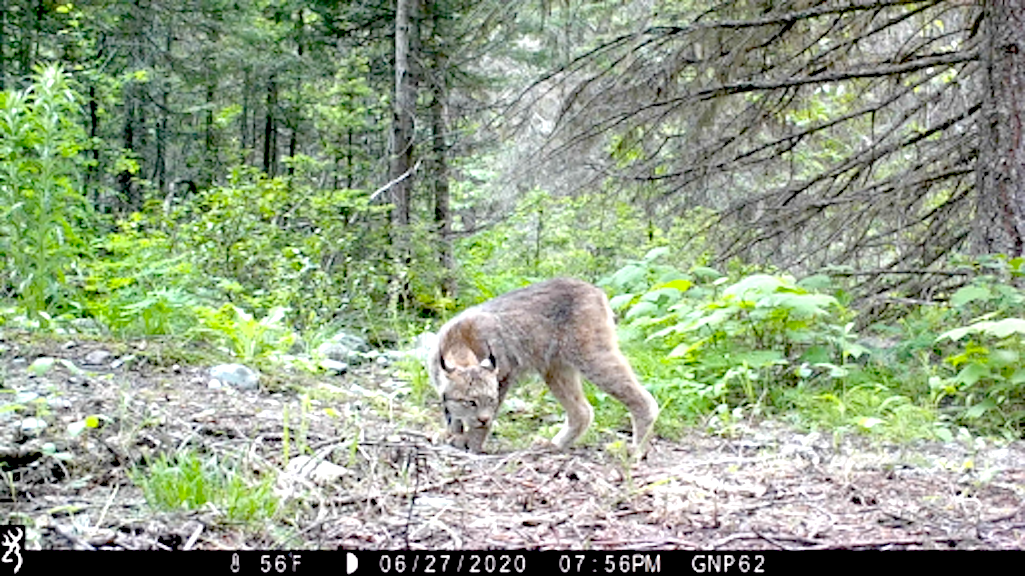
Glacier National Park could serve as a climate refugia for Canada lynx/USFWS file
Glacier National Park, famous for its mountain goats and grizzly bears, holds a surprising number of Canada lynx and could prove to be a climate refugia for the cats, according to researchers.
"Glacier National Park is one of the few, large, protected areas located within Canada lynx range in the contiguous United States, and therefore a potentially important lynx stronghold within the Northern Rockies lynx recovery unit," noted researchers from Washington State University who used remote sensing cameras to document the cats from 2018-2021.
While the roughly 50 lynx in the national park in northern Montana hard against the Canadian border represent a less dense population than that found farther north in Canada, the researchers nevertheless concluded that "park-wide abundance was substantial for this threatened predator. Based on our results, we propose that GNP should be considered as a potentially important area for lynx habitat refugia in a warming climate."
The study found an almost equal distribution of lynx on both sides of the Continental Divide, and spurred a conclusion that "lynx may reduce how often they use sites with high human presence but not avoid those sites entirely. Other studies suggest that lynx are tolerant of low-moderate levels of recreation, and are likely to occupy highly suitable habitat in the presence of recreation. Therefore, on average across GNP, recreation levels may not be high enough to trigger wholesale spatial avoidance. Another explanation for a muted response of lynx to recreation could be that recreation in GNP is mostly concentrated on trails and may occur in a predictable enough fashion that lynx were able to cope to some degree."
As to whether Glacier might serve as a climate refugia for the cats, the researchers noted that "[G]iven GNP is broadly occupied by lynx and contains a great deal of land above the current average, and even maximum, elevation currently used by lynx, this flagship protected area may become increasingly important as a climatic refugia for this species in the future. While we do not know for certain how species will react to climate change, upslope migration of boreal habitats may enable lynx to survive in GNP and the Northern Rockies even with expected reductions in habitat suitability."

Image of a Canada lynx taken by a motion sensitive camera as part of a study conducted in Glacier National Park/WSU, Alissa Anderson
According to the U.S. Fish and Wildlife Service, the "mid-sized boreal forest carnivore" occurs across most of northern North America, but in "the contiguous United States, Canada lynx were designated as a distinct population segment and listed as threatened under the Endangered Species Act in 2000."
Small in size, between 15 and 30 pounds, lynx have distinctive tufts on the top of their ears and large, fur-covered feet and powerful hind legs that allow them to chase down snowshoe hares, their primary prey, in the snow, the Fish and Wildlife Service notes in its profile of the predator.
Last summer the wildlife agency announced that it was embarking on a five-year status review of lynx to determine current populations.
In Glacier, the Washington State University team determined that Canada lynx reside across most of Glacier’s 1,600-square-mile landscape.
“The population in the park is still substantial and exceeded our expectations,” said Dan Thornton, WSU wildlife ecologist and senior author of the study recently published in the Journal of Wildlife Management. “Our results suggest the park could provide a much-needed climate refuge for the cats in the future.”
At the national park, Supervisory Wildlife Biologist Dr. John Waller told the Traveler that he agrees that the park "should be considered an important area for lynx refugia, and with the conclusion that while lynx occur at low-density in the park compared to other core areas of lynx range, that the number of lynx detected park-wide was substantial."
At the same time, Waller also said it's "possible the park could be a climate refuge for lynx. The park has adequate habitat for the existing lynx population, but many unknowns exist that could change this significantly."
Also hard to answer, he said, was whether the park's population could grow significantly.
"The lynx population is dependent on adequate habitat existing for their needs and adequate food sources. If both of these parameters can be maintained, then it is possible that lynx numbers could increase, though lynx populations are generally not very dense," Waller said in an email.
The WSU researchers noted that Glacier's landscape doesn't make it easy to count lynx.
“Most surveys for lynx happen in the winter when you can use bait to lure the animals to live traps,” said Alissa Anderson, a recent WSU master’s graduate and first author on the study. “Glacier is sort of unique in the sense that it is a difficult place to survey in the wintertime. There aren’t really maintained roads and you can’t use snowmobiles. It is extremely difficult to access compared to other areas.”
To work around that, the researchers worked with park staff to set up 300 motion-sensitive cameras about a kilometer apart on hiking trails across much of the park, including remote backcountry areas. Their analysis revealed that lynx are distributed not only across most of the park but also at lower elevations, which could prove useful as the climate continues to warm.
“The main question regarding the lynx’s survival is climate change,” Thornton said. “They are a cold-adapted species that needs deep snow. In Glacier at least, they have a lot of room to move up in elevation as the climate warms.”
Historical Presence
Historically, the predator’s habitat extended from Alaska and Canada south down into much of the northern United States, a university release noted. In the lower 48, the Canada lynx exist only in several disjunct populations in Maine, Minnesota, Montana, Colorado, Idaho, and Washington.
According to the National Park Service, lynx were thought to be present, but uncommon, in Yellowstone National Park at least from 1880 to 1980. More recent sightings indicate the Greater Yellowstone Ecosystem's habitat met the needs of lynx.
"The presence and distribution of lynx in the park was documented during 2001 to 2004, when several individuals were detected in the vicinity of Yellowstone Lake and the Central Plateau. A lynx was photographed in 2007 along the Gibbon River, and another lynx was observed near Indian Creek Campground in the northwestern portion of Yellowstone during 2010," the park notes on its website. "Tracks of an individual were verified near the Northeast Entrance in 2014. Reliable detections of lynx continue to occur in surrounding National Forest System lands. Evidence suggests lynx successfully reproduce in the GYE, though production is limited."
According to the Fish and Wildlife Service's last five-year status review of the cat, in 2017, the agency said it was uncertain whether Yellowstone ever held a persistent lynx population. However, while the agency said it wasn't likely that Colorado historically had a lynx population, it noted that a resident population persisted in the San Juan Mountains in the southwestern reach of the state following the introduction of 218 lynx from Canada and Alaska there between 1999-2006.
The review did not mention any populations in Glacier National Park or elsewhere in Montana.



Add comment